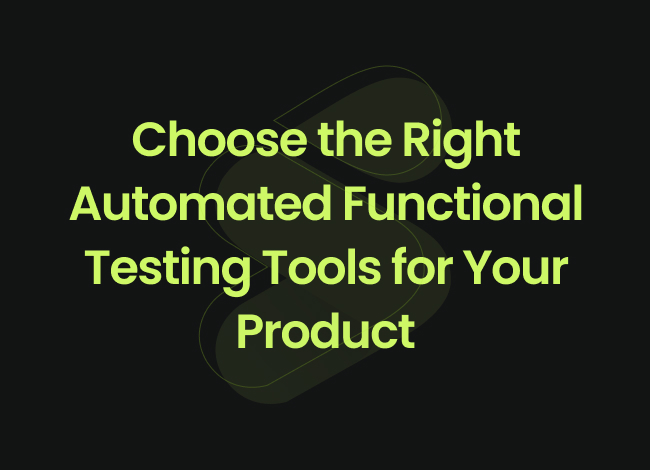Introduction
Sustaining consumer satisfaction is well-grounded in having an excellent product which must work optimally. This cannot be achieved without automated functional testing tools
since this will ensure your product satisfies business requirements besides being error free. Since functional testing occupies an important position in the course of the Software Development Life Cycle (SDLC), it is important to ensure that it is implemented effectively as well as with a maximum level of efficiency. However, this is where the best automated functional testing tools are of great help to us. But the question is, how do one go about choosing the right tools for the job? All this we are going to explore in this article.
Understanding Automated Functional Testing:
Automated functional testing is actually a software testing technique which incorporates the use of testing tools and scripts to test an application for functionality. Approach testing targets the certification of the features and functionality of an application in relation to defined specifications and documented user requirements. Because of its distinguishing features, Choosing the right functional testing tools is crucial for ensuring your application meets its requirements and performs as expected.
Advantages Of Automated Functional Testing:
- Efficiency: The tests can be run much quicker than the manual tests; therefore, shortening the amount of testing time and making it possible to perform tests more frequently.
- Reusability: Being generated from the test cases, the test scripts can be used in subsequent versions of the application thus saving a lot of time when developing tests.
- Accuracy: Thus, it is much easier, faster and efficient to administer and receive more accurate results from the automated tests than from tests that involve humans.
- Coverage: Automated testing ensures that many test cases can be conducted, including nested cases and cases that are typically hard to test by ordinary approach.
- Continuous Testing: Integration of automated tests into CI/CD pipeline is possible hence making testing to be continuous and feedback to be fast when changes are made on codes.
Choose the Right Automated Functional Testing Tools for Your Product
Picking the best tools for functional testing automation can be of great importance in order to make sure that your product functions as required. Here’s a guide to help you make the best choice:
1. Understand Your Testing Requirements
For the best automated functional testing software, it is important to define your testing requirements. It includes:
- Application Type: Determine the class of your application which can be web based, mobile or a desktop application.
- Test Coverage: Subsequently, identify the functionalities to be tested and see if they can be satisfied by the tool in hand.
- Integration Needs: Make sure the tool works seamlessly within your existing software development and Continuous Integration/Continuous Delivery frameworks.
Siznam’s Tip: Develop a plan to decide on the necessity of certain types of tests; create a list of indicators to help reject non-essential aspects of the tools.
2. Evaluate Tool Features and Capabilities
When choosing right automated functional testing tools, consider its features and capabilities:
- Support for Multiple Platforms: Check that the generated tool can be integrated with platforms, on which your application functions (Web, Mobile or Desk).
- Ease of Use: For functional testing tools selection with a well-designed GUI and such aspects as scriptability or the possibility to set up and modify a tool’s parameters without scripting at all. An easy to use product makes the learning curve shallow and implementation much faster.
- Script Creation and Maintenance: Determine if scriptless or low-code test creation is possible with the tool. This may prove useful with less programing experience teams.
Siznam’s Tip: Select free trial or demo for choosing the right functional testing tools, for ease of use. This is important as it gives the potential user the feel of the performance of the tool and its usability without making a full commitment.
3. Consider Integration with Other Tools
The workflow integration is important for functional testing automation tools for your product and must have all the necessary facilities to make them compatible. Your functional testing tools for automation should integrate well with:
- Development Environments: Ideally, it must be compatible and usable with IDEs and development tools employed by the other members of your team.
- CI/CD Tools: For automated functional testing solutions, It is crucial to integrate with other tools such as continuous integration and continuous deployment tools like Jenkins, GitLab or Azure DevOps to run tests and generate reports.
- Bug Tracking Systems: For best tools for automated functional testing, most of the clients require integrating the tool with bug tracking tools to enhance defect management and assure the problems’ identification on time.
Siznam’s Tip: Check if the integration options you choose functional testing tools do not disrupt the workings of your team tools for functional testing automation software and processes that have been put in place.
4. Assess Reporting and Analytics
For the ability to draw accurate conclusions as well as evaluate test results, it is important to have proper reporting and analytics. Look for those functional testing automation best tools that provide:
- Detailed Test Reports: Complete reports with general scores, program performances, time taken, and complete report of the tests.
- Analytics and Insights: Sophisticated analysis with constituents, inclinations, and problems that one company is likely to experience or come across.
- Customizable Dashboards: Interactive and customisable dashboards that can be tweaked for the better understanding and monitoring of your team.
Siznam’s Tip: Report generation should also be well maximized for top automated functional testing tools, as well as the visualization options for data on a dashboard. This makes it possible to monitor test results and come up with further data analysis more effectively.
5. Evaluate Support and Community
The quality of support and the strength of the best functional testing automation tools community can greatly influence your experience:
- Vendor Support: Determine if the identified automated functional testing tools come with sound customer support facilities such as documentation, training, and help desks.
- Community and Forums: A sound community and the presence of forums can be beneficial for problem-solving and exchanging the experience in best automated functional testing tools.
Siznam’s Tip: Go to the respective websites o to choose functional testing tools that you are going to purchase and read customer reviews and case studies to determine its support and community.
6. Analyze Cost and Licensing
Price is another consideration that can be used in the process of evaluating best tools for functional testing automation. Consider:
- Pricing Model: Get acquainted with pricing and potential licensing terms of automated functional testing software tools, subscription fees, or per-featured or per-support basis pricing.
- Scalability: Make sure that with the right automated functional testing tools pricing structure can expand as your expectations for your project or the number of employees in the team will do.
Siznam’s Tip: Compare total cost for the tools for functional testing tools selection and possibly the amount of extra costs as well as additional expenditure in case they would be required for future expansion.
Best Automated Functional Testing Tools:
Here are some of the top automation testing tools:
Selenium
Selenium is a popular tool for testing among the best functional testing automation tools. It’s free to use and works with different web browsers. Many people choose it because it is reliable and has a strong community for support. Selenium stands out in functional testing tools comparison of all tools.
QTP/UFT
QTP, also called UFT, is a favorite testing tool. It’s easy to use and works with many types of applications. Testers like it for its simplicity and the wide range of features it offers in all top automated functional testing tools.
TestComplete
TestComplete is a strong tool for testing. It makes creating and running tests easy. This helps ensure your product works well without issues, saving time and effort in the long run. Many testers prefer testcomplete in functional testing automation best tools for its distinguishing features.
Ranorex
Ranorex is another one of the best functional testing automation software. It has a simple interface and works with many technologies. This makes it suitable for different testing needs, from small projects to larger ones.
Katalon Studio
Katalon Studio is a top choice for testing tools because it provides effective automated functional testing solutions. It’s easy to set up and use, which helps speed up the testing process for your product. Its user-friendly design makes it accessible to everyone.
Cucumber
Out of all automated functional testing software, Cucumber holds a special place. Cucumber is great for testing with a team. It allows everyone, technical or not, to work together on testing. This ensures thorough checks and helps improve communication within the team.
Appium
Appium is a great tool in the best tools for automated functional testing for mobile apps. It works with both Android and iOS, making it versatile and widely used. Its flexibility makes it a popular choice for mobile testing.
SoapUI
SoapUI is perfect for testing web services. It makes the process simple, ensuring your services work reliably and efficiently. Its straightforward approach helps in catching issues early. It Is the best functional testing tool for automation.
Tricentis Tosca
In functional testing automation tools for your product, Tricentis Tosca is known for its unique approach. It helps create tests that are easy to use again, making testing more efficient. This saves time and ensures better coverage.
Eggplant
When choosing the right functional testing tools, Eggplant is special because it tests from the user’s view. This ensures your product delivers a great experience for the end user. Its user-focused approach makes it stand out from other tools.
Conclusion:
Choosing the right automated functional testing tool is key to ensuring your software functions correctly. Start by defining what you need from the tool, then assess its features, compatibility with your systems, support, and costs. This approach will help you select the best automated functional testing tools for your project. Don’t forget to use free trials and check expert reviews to get the most value at Siznam. For more tips on selecting testing tools and strategies, visit Siznam to stay updated on the latest in software testing.
People Also Ask
Selenium WebDriver is one of the most widely used tools for automated functional testing. It’s open-source, supports multiple programming languages (Java, Python, C#, Ruby, JavaScript), and can be used to automate web applications across different browsers and operating systems.
Other popular tools for automated functional testing include:
- Cypress: A modern JavaScript-based end-to-end testing framework known for its simplicity and speed.
- Playwright: A powerful automation library that supports multiple programming languages and browsers.
- Appium: A tool for mobile app testing, but it can also be used for web automation on mobile devices.
When choosing automation tools, consider the following factors:
- Project Requirements: Assess the complexity of the application, the scope of testing, and the specific features to be automated.
- Team Expertise: Evaluate the team’s technical skills and experience with different tools.
- Tool Capabilities: Consider the tool’s ability to support your testing needs, such as cross-browser compatibility, performance testing, and integration with other tools.
- Cost: Evaluate the cost of the tool, including licensing fees and maintenance costs.
- Ease of Use: A user-friendly tool can significantly reduce the learning curve and improve productivity.
- Community Support: A strong community can provide valuable resources, tutorials, and support.
Selenium offers a suite of tools for different testing needs. Here’s how to choose the right one:
- Selenium WebDriver: For browser automation, interacting with web elements, and performing complex test scenarios.
- Selenium IDE: A browser extension for recording and playing back test scripts, suitable for simple test cases.
- Selenium Grid: For distributed testing, allowing you to execute tests on multiple browsers and operating systems simultaneously.
Automated functional testing is a software testing technique that involves using automated tools to execute test cases and validate the functionality of a software application. By automating repetitive tasks, it helps to improve testing efficiency, accuracy, and coverage. Automated functional tests can be used to verify that the application’s features work as expected, identify defects early in the development process, and ensure consistent quality.





